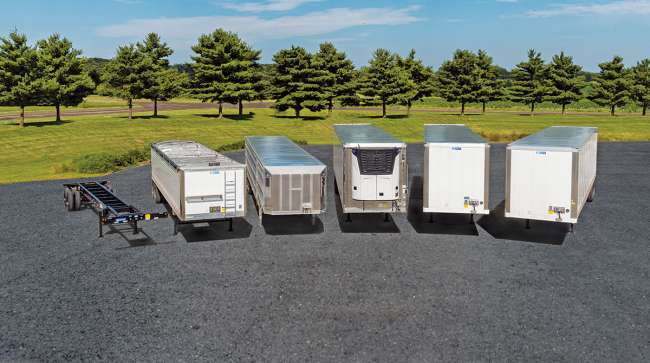Senior Reporter
May Trailer Orders at Year’s Low, but Double That of 2021 Period

[Stay on top of transportation news: Get TTNews in your inbox.]
U.S. trailer orders in May fell to the lowest point this year as they just cleared 18,000. But they also soared way above the 2021 period’s volume, which was the lowest for that year.
Orders, buttressed by dry vans, increased 111% to 18,300 compared with 8,676 a year earlier, ACT Research reported, citing trailer makers’ preliminary data. Final May results will be available later in the month.
“We are getting closer to the 2023 opening. Fleets and the trailer makers are talking with each other. The order volume could have dropped more, but it didn’t, setting the stage for when the order boards are officially opened,” Jennifer McNealy, director of commercial vehicle market research at ACT, told Transport Topics.
ACT Research: May Preliminary US Trailer Net Orders Fall Sequentially, but Gain Against May’21https://t.co/lLhqSjitW2 — ACT Research (@actresearch) June 14, 2022
FTR also pegged preliminary numbers at 18,300, and noted conditions have changed little from April: The industry continues to face economic uncertainties, geopolitical risks and continued supply chain disruptions.
“Despite economic and supply chain uncertainties, freight growth remains strong. This growth will continue to drive robust fleet replacement demand,” said Charles Roth, analyst for commercial vehicles at FTR.
“We have seen modest improvements made on the supply side. Provided this trend continues, production should remain stable,” he said. “While the prior six months have resulted in dealers struggling to maintain adequate inventory levels, retail demand should also contribute to trailer makers’ confidence heading into the second half of the year.”
Trailer makers said they were doing the best they could under circumstances that remain challenging.
“We are accepting Q4 orders now, and they are coming in strongly,” Craig Bennett, senior vice president at Utility Trailer Manufacturing Co., told Transport Topics. “But 2023 is still not open to quoting.”
Bennett said supply lines remain very tight and “are stretched thin”; labor is also tight.

Hammond
Chris Hammond, executive vice president of sales at Great Dane, said all trailer makers are carefully managing the timing orders placed on the schedule. He agreed there still were issues in the supply chain, with labor and foam for panels, that are making it challenging to confidently schedule those orders.
“We have not booked for next year,” Hammond said, “but are working with our distribution and end-user partners on what 2023 and beyond will look like. I don’t think we’ll open up until midsummer at the earliest.”
And there is inflation, of course; and his customers are dealing with a lot of it, and with their own supply chain disruptions, and securing drivers and support staff, he said.
“We sincerely appreciate their patience and support over the past couple of years as we all drive toward something that more resembles normalcy,” Hammond said.
Sean Kenney, chief sales officer at Hyundai Translead, said he suspects orders will remain “rather low” until orders are taken for 2023.
He said Hyundai Translead was continuing to evaluate “the current operating environment in light of industry demand, and are hopeful of opening 2023 orders in the mid- to late third quarter.”
Another trailer maker executive said the manufacturers want to change promised slots into actual written orders so they have visibility to execute production.

Giesen
“The demand has not changed for the industry and it actually far exceeds the capacity,” said David Giesen, vice president of sales at Stoughton Trailer.
He added Stoughton has not booked anything for 2023 yet, and was waiting on more certainty in the supply chain, with labor, and what capacity will actually be. “The supply chain is still very much strained for many components. Each week is a challenge just figuring out what we will be able to build.”
In related news, Wabash announced it will create what it called “a new tech-enabled” Wabash Parts distribution network.
This single-channel distribution network will, over time, include the entire Wabash aftermarket portfolio as well as a wide range of transportation parts, and is intended to provide increased inventory and faster shipping.
The company reported the distribution process will use the company’s own network of equipment dealers’ service capabilities, as well as the infrastructure of industry-leading partners, involving multiple distribution centers across the country.
It did not immediately identify those distributors or locations.
Wabash Parts and Services distribution capabilities currently serve van trailer and truck body customers and dealers. Parts distribution for other Wabash product lines will phase in throughout 2022, according to the Lafayette, Ind.-based company.
Want more news? Listen to today's daily briefing below or go here for more info:




